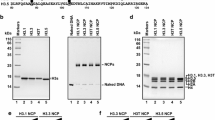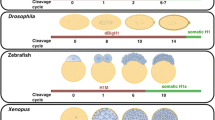Abstract
The mammalian H1 histone gene complement consists of at least seven H1 protein isoforms. These include five S-phase-dependent H1 protein subtypes and two more distantly related proteins, which are expressed upon terminal differentiation (H10) or during the pachytene stage of spermatogenesis (H1t). In the past, three replication-dependent murine H1 genes plus the H1 0 and H1t genes have been isolated and characterized. In this report, we describe the sequences of two more H1 genes, and we show that all five murine replication-dependent H1 genes and the H1t gene map to the region A2-3 on Chromosome (Chr) 13. This is in agreement with our previous finding that the human H1 histone gene complement maps to 6p21.3, which corresponds to the A2-3 region on the murine Chr 13. Previous reports have shown that the replication-independent H1 0 genes map to syntenic regions on Chrs 22 (human H10) and 15 (murine H1 0).
Similar content being viewed by others
References
Albig, W., Kardalinou, E., Drabent, B., Zimmer, A., Doenecke, D. (1991). Isolation and characterization of two human H1 histone genes within clusters of core histone genes. Genomics 10, 940–948.
Albig, D., Drabent, B., Kunz, J., Kalff-Suske, M., Grzeschik, K.H., Doenecke, D. (1993). All known human H1 histone genes except the H10 gene are clustered on chromosome 6. Genomics 16, 649–654.
Allan, J., Hartman, P.G., Crane-Robinson, C., Aviles, F.X. (1980). The structure of histone H1 and its location in chromatin. Nature 288, 675–679.
Allan, J., Mitchell, T., Harborne, N., Bohm, L., Crane-Robinson, C. (1986). Roles of H1 domains in determining higher order chromatin structure and H1 location. J. Mol. Biol. 187, 591–601.
Alonso, A., Breuer, B., Bouterfa, H., Doenecke, D. (1988). Early increase in histone H10 mRNA during differentiation of F9 cells to parietal endoderm. EMBO J. 7, 3003–3008.
Bartram, C.R., de Klein, A., Hagemeijer, A., Grosveld, G., Hiesterkamp, N., Groffen, J. (1984). Localization of the human c-sis oncogene in Ph1-positive and Ph1-negative chronic myelocytic leukemia by in situ hybridization. Blood 63, 223–225.
Birnstiel, M.L., Busslinger, M., Strub, K. (1985). Transcription termination and 3′ processing. The end is in site! Cell 41, 349–359.
Brannan, C.I., Gilbert, D.J., Ceci, J.D., Matsuda, Y., Chapman, V.M., Mercer, J.A., Eisen, H., Johnston, L.A., Copeland, N.G., Jenkins, N.A. (1992). An interspecific linkage map of mouse chromosome 15 positioned with respect to the centromere. Genomics 13, 1075–1081.
Brown, D.T., Sittman, D.B. (1993). Identification through overexpression and tagging of the variant type of the mouse H1e and H1c genes. J. Biol. Chem. 268, 713–718.
Castiglia, D., Gristina, R., Scaturro, M., DiLiegro, I. (1993). Cloning and analysis of cDNA for rat histone H10. Nucleic Acids Res. 21, 1674.
Cheng, G., Skoultchi, A.I. (1989). Rapid induction of polyadenylated H1 histone mRNAs in mouse erythroleukemia cells is regulated by c-myc. Mol. Cell. Biol. 9, 2332–2340.
Cole, K.D., Kandala, J.C., Kistler, W.S. (1986). Isolation of the gene for the testis-specific H1 histone variant H1t. J. Biol. Chem. 261, 7178–7183.
Cole, K.D., Kanadala, J.C., Kremer, E., Kistler, W.S. (1990). Isolation of a genomic clone encoding the rat histone variant, H1d. Gene 89, 265–290.
Cole R.D. (1987). Microheterogeneity in H1 histones and its consequences. Int. J. Peptide Protein Res. 30, 433–449.
Coles, L.S., Wells, J.R.E. (1985) An H1 histone gene specific 5′ element and evolution of H1 and H5 genes. Nucleic Acids Res. 13, 585–594.
Cooke, N., Szpirer, C., Levan, G. (1986). The related genes encoding growth hormone and prolactin have been dispersed to chromosome 10 and 17 in the rat. Endocrinology 119, 2451–2454.
Cox, D.R., Groppi, V.E., Bieber, D., Sittman, D.B., Coffino, P., Marzluff, W.F. (1984). Assignment of murine histone genes to mouse chromosome 13. Cytogenet. Cell Genet. 37, 443 (Abstract).
Dalton, S., Wells, J.R.E. (1988). A gene specific promoter element is required for optimal expression of the histone H1 gene in S-phase. EMBO J. 7, 49–56.
D'Andrea, R., Coles, L.S., Lesníkowski, C., Tabe, L., Wells, J.R.E. (1985). Chromosomal organization of chicken histone genes: preferred associations and inverted duplications. Mol. Cell. Biol. 5, 3108–3115.
Doenecke, D., Tönjes, R. (1986). Differential distribution of lysine and arginine residues in the closely related histones H10 and H5. Analysis of a human H10 gene. J. Mol. Biol. 187, 461–464.
Doenecke, D., Albig, W., Bouterfa, H., Drabent, B. (1994). Organization and expression of H1 histone and H1 replacement histone genes. J. Cell. Biochem. 54, 423–431.
Dong, Y., Sirotkin, A.M., Yang, Y.S., Brown, D.T., Sittman, D.B., Skoultchi, A.L. (1994). Isolation and characterization of two replication dependent mouse H1 histone genes. Nucleic Acids Res 22, 1421–1428.
Drabent, B., Kardalinou, E., Doenecke, D. (1991). Structure and expression of the human gene encoding testicular H1 histone (H1t). Gene 103, 263–268.
Drabent, B., Bode, C., Doenecke, D. (1993). Structure and expression of the mouse testicular H1 histone gene (H1t). Biochim. Biophys. Acta 1216, 311–313.
Eick, S., Nicolai, M., Mumberg, D., Doenecke, D. (1989). Human H1 histones: conserved and varied sequence elements in two H1 subtype genes. Eur. J. Cell Biol. 49, 110–115.
Fang, X.E., Yoshida, M.C., Naylor, S.L., Sakaguchi, A.Y. (1985). Chromosomal mapping of rat cellular oncogenes and growth factor genes. Cytogenet. Cell Genet. 40, 627.
Franklin, S.G., Zweidler, A. (1977). Non-allelic variants of histones 2a, 2b and 3 in mammals. Nature 266, 273–274.
Graves, R.A., Wellman, S.E., Chiu, I.M., Marzluff, W.F. (1985). Differential expression of two clusters of mouse histone genes. J. Mol. Biol. 183, 179–194.
Green, L.G., van Antwerpen, R., Stein, J., Stein, G., Triputti, P., Emanuel, B., Selden, J., Croce, C. (1984). A major histone gene cluster on the long arm of chromosome 1. Science 226, 838–840.
Gruber, A., Streit, A., Reist, M., Benninger, P., Böhni, R., Schümperli, D. (1990). Structure of a mouse histone-encoding gene cluster. Gene 95, 303–304.
Hameister, A., Adolph, S., Deimling, O., Meyer, J. (1989). Physical and genetic linkage map of murine chromosome 15. Cytogenet. Cell Genet. 51, 1010.
Heintz, N., Zernik, M., Roeder, R.G. (1981). The structure of the human histone genes: clustered, but not tandemly repeated. Cell 14, 661–668.
Hentschel, C.C., Birnstiel, M.L. (1981). The organization and expression of histone gene families. Cell 25, 301–313.
Holcombe, R.F., Stephenson, D.S., Zweidler, A., Stewart, R.M., Chapman, V.M., Seidman, J.G. (1991). Linkage of loci associated with two pigment mutations on mouse chromosome 13. Genet. Res. 58, 41–50.
Justice, M.J., Stephenson, D.A. (1993). Mouse chromosome 13. Mamm. Genome 4 (suppl.), S192-S202.
Kardalinou, E., Eick, S., Albig, W., Doenecke, D. (1993). Association of a human H1 histone gene with an H2A pseudogene and genes encoding H2B.1 and H3.1 histones. J. Cell. Biochem. 52, 375–383.
LaBella, F., Gallinari, P., McKinney, J., Heintz, N. (1989). Histone H1 subtype-specific consensus elements mediate cell cycle-regulated transcription in vitro. Genes Dev. 3, 1982–1990.
Lennox, R.W. (1984). Differences in evolutionary stability among mammalian H1 subtypes. Implications for the roles of H1 subtypes in chromatin. J. Biol. Chem. 259, 669–672.
Lennox, R.W., Cohen, L.H. (1984). The alterations in H1 histone complement during mouse spermatogenesis and their significance for H1 sub-type function. Dev. Biol. 103, 80–84.
Lichter, P., Cremer, T., Borden, J., Manuelidis, L., Ward, D.C. (1988). Delineation of individual human chromosomes in metaphase and interphase cells by in situ suppression hybridization using recombinant DNA libraries. Hum. Genet. 80, 224–234.
Liu, T.J., Levine, B.J., Skoultchi, A.I., Marzluff, W.F. (1989). The efficiency of 3′-end formation contributes to the relative levels of different histone mRNAs. Mol. Cell. Biol. 9, 3499–3508.
Maxson, R., Cohn, R., Kedes, L. (1983). Expression and organization of histone genes. Annu. Rev. Genet. 17, 239–277.
Nigg, E.A. (1993). Cellular substrates of p34cdc2 and its companion cyclin-dependent kinases. Trends Cell Biol. 3, 296–301.
Ohe, Y., Hayashi, H., Iwai, K. (1989). Human spleen histone H1. Isolation and amino acid sequences of three minor variants, H1a, H1c and H1d. J. Biochem. 106, 844–857.
Owen, F.L., Taylor, B.A., Zweidler, A., Seidman, J.G. (1986). The murine γ-chain of the T cell receptor is closely linked to a spermatocyte specific histone gene and the beige coat color locus on chromosome 13. J. Immunol. 137, 1044–1046.
Paranjape, S.M., Kamakaka, R.T., Kadonaga, J.T. (1994). Role of chromatin structure in the regulation of transcription by RNA polymerase II. Annu. Rev. Biochem. 63, 265–297.
Parseghian, M.H., Henschen, A.H., Krieglstein, K.G., Hamkalo, B.A. (1994). A proposal for a coherent mammalian histone H1 nomenclature correlated with amino acid sequences. Protein Sci. 3, 575–587.
Said, K., Jacqurt, T., Montelgard, C., Sonjaya, H., Helal, A.N., Britton-Davidian, J. (1986). Robertsonian house mouse population in Tunesia: a karyological and biochemical study. Genetica 68, 151–156.
Schümperli, D. (1988). Multilevel regulation of replication-dependent histone genes. Trends Genet. 4, 187–191.
Simpson, R.T. (1978). Structure of the chromatosome, a chromatin particle containing 160 base pairs of DNA and all the histones. Biochemistry 17, 5524–5531.
Sittman, D.B., Chiu, I.M., Pan, C.J., Cohn, R.H., Kedes, L.H., Marzluff, W.F. (1981). Isolation of two clusters of mouse histone genes. Proc. Natl. Acad. Sci. USA 78, 4078–4082.
Sittman, D.B., Graves, R.A., Marzluff, W.F. (1983). Structure of a cluster of mouse histone genes. Nucleic Acids Res. 11, 6679–6697.
Stein, G.S., Stein, J.L., Marzluff, W.F. (1984). Histone Genes, Structure, Organization, and Regulation (New York: John Wiley and Sons).
Tchouatcha-Tchouassom, J.C., Juillard, J.H., Roux, B. (1989). Isolation and characterization of five histone H1 subtypes from adult rat liver. Biochim. Biophys. Acta 1009, 121–128.
Thoma, F., Koller, T., Klug, A. (1979). Involvement of histone H1 in the organization of the nucleosome and of salt dependent superstructures of chromatin. J. Cell Biol. 83, 403–427.
Tripputi, P., Emanuel, B.S., Croce, C.M., Green, L.G., Stein, G.S., Stein, J.L. (1986). Human histone genes map to multiple chromosomes. Proc. Natl. Acad. Sci. USA 83, 3185–3188.
Van Holde, K.E. (1989). Chromatin. (Berlin: Springer Verlag).
Wolffe, A.P. (1992) Chromatin: Structure and Function. (London: Academic Press).
Yamada, J., Kuramoto, T., Serikawa, T. (1994). A rat genetic linkage map and comparative maps for mouse or human homologous rat genes. Mamm. Genome 5, 63–83.
Yang, Y.S., Brown, D.T., Wellman, S.E., Sittman, D.B. (1987). Isolation and characterization of a mouse fully replication-dependent H1 gene within a genomic cluster of core histone genes. J. Biol. Chem. 262, 17118–17125.
Yasue, M., Serikawa, T., Kuramoto, T., Mori, M., Higashigushi, T., Ishizaki, K., Yamada, J. (1992). Chromosomal assignments of 17 structural genes and 11 related DNA fragments in rats (Rattus norvegicus) by Southern blot analysis of rat x mouse somatic cell hybrid clones. Genomics 12, 659–664.
Zlatanova, J., Doenecke, D. (1994). Histone H10: a major player in cell differentiation? FASEB J. 8, 1260–1268.
Author information
Authors and Affiliations
Rights and permissions
About this article
Cite this article
Drabent, B., Franke, K., Bode, C. et al. Isolation of two murine H1 histone genes and chromosomal mapping of the H1 gene complement. Mammalian Genome 6, 505–511 (1995). https://doi.org/10.1007/BF00356166
Received:
Accepted:
Issue Date:
DOI: https://doi.org/10.1007/BF00356166




